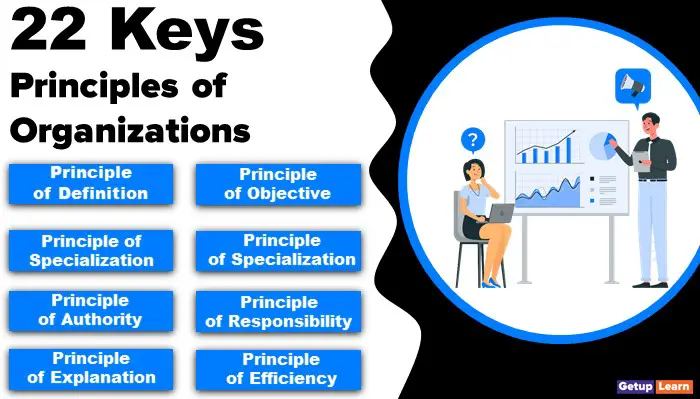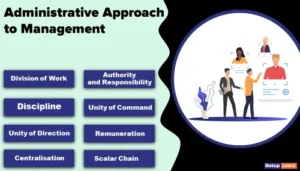
Table of Contents
-
1 22 Key Principles of Organizations
- 1.1 Principle of Definition
- 1.2 Principle of Objective
- 1.3 Principle of Specialization
- 1.4 Principle of Coordination
- 1.5 Principle of Authority
- 1.6 Principle of Responsibility
- 1.7 Principle of Explanation
- 1.8 Principle of Efficiency
- 1.9 Principle of Uniformity
- 1.10 Principle of Correspondence
- 1.11 Principle of Unity of Command
- 1.12 Principle of Balance
- 1.13 Principle of Equilibrium
- 1.14 Principle of Continuity
- 1.15 Principle of Span of Control
- 1.16 Principle of Leadership Facilitation
- 1.17 Principle of Exception
- 1.18 Principle of Flexibility
- 1.19 Scalar Principle
- 1.20 Principle of Simplicity and Homogeneity
- 1.21 Principle of Unity in Direction
- 1.22 Principle of Joint Decisions
- 2 FAQ Related to 22 Key Principles of Organizations
22 Key Principles of Organizations
These are the 22 key principles of organizations given below:
- Principle of Definition
- Principle of Objective
- Principle of Specialization
- Principle of Coordination
- Principle of Authority
- Principle of Responsibility
- Principle of Explanation
- Principle of Efficiency
- Principle of Uniformity
- Principle of Correspondence
- Principle of Unity of Command
- Principle of Balance
- Principle of Equilibrium
- Principle of Continuity
- Principle of Span of Control
- Principle of Leadership Facilitation
- Principle of Exception
- Principle of Flexibility
- Scalar Principle
- Principle of Simplicity and Homogeneity
- Principle of Unity in Direction
- Principle of Joint Decisions

Principle of Definition
Defining and fixing the duties, responsibilities, and authority of each worker. In addition, when a group of persons is working together for a common goal, it becomes necessary to define the relationship between them in clear terms.
Principle of Objective
The activities at all levels of the organizational structure should be geared to achieve the main objectives of the organization.
Principle of Specialization
Principle of specialization or division of work: It includes deciding and division of various activities required to achieve the objectives of an organization. Identical activities are grouped under one individual or one department.
In order to ensure effective performance, the grouped activities are allotted to specified competent persons, specialized in their fields. Adequate staff members are appointed under them and are appropriately trained.
Principle of Coordination
Coordination must exist among the workers. The delegated authority and responsibility should be coordinated by the chief managerial staff.
There must be a separate and responsible person to see whether all the activities are going on to accomplish the objectives of the organization or not.
Assignment of duties or allotment of duties to specified persons is followed by a delegation of authority. While delegating authority, responsibility is also fixed.
The senior members should delegate the authority to their subordinates on the basis of their ability. The subordinates are motivated through the delegation of authority and they perform the work efficiently with responsibility.
Principle of Responsibility
Each person is responsible for the work completed by him. Authority is delegated from the top level to the bottom level but the responsibility can be delegated to some extent.
While delegating authority, there is no need to delegate responsibility. So, the responsibility of the junior staff members should be clearly defined.
Principle of Explanation
While allocating duties to persons, the extent of liabilities of the person should be clearly explained to the concerned person. It will enable the person to accept the authority and discharge his duties efficiently.
Principle of Efficiency
Each work can be completed efficiently wherever the environment as well as the organizational structure facilitates the completion of work. The work should be completed with minimum members, in less time, with minimum resources, and within the right time.
Principle of Uniformity
The organization should distribute the work in such a way that there should be equal status and equal authority and powers among the same line officers.
Principle of Correspondence
Authority and responsibility should be in parity with each other. If authority alone is delegated without responsibility, it could be misused. Secondly, if responsibility is delegated without authority, it will not work.
Principle of Unity of Command
A subordinate should receive instructions or directions only from one superior.
Principle of Balance
The sequence of work between various units of the organization should be arranged scientifically.
Principle of Equilibrium
In certain periods, some departments are overloaded and some are underloaded. The overloaded departments should be further divided into sub-sections. This would facilitate effective control.
Principle of Continuity
There should be a reoperation of objectives, readjustment of plants, and provision of opportunities for the development of future management.
Principle of Span of Control
It refers to the maximum number of members effectively supervised by a single individual. In the administration area, under one executive, four or five subordinates may work.
At the factory level, under one supervisor, twenty or twenty-five workers may work. The span of control enables the smooth functioning of the organization.
Principle of Leadership Facilitation
The organizational setup may be arranged in such a way that the persons with leadership qualities such as honesty, devotion, enthusiasm, and inspiration are appointed to key positions.
Principle of Exception
The junior officers should be disturbed by the seniors only when the work is not done according to the plans laid down. It automatically reduces the work of middle-level as well as top-level officers.
The top-level officers will have more time to frame policies and chalk out the plans of the organization.
Principle of Flexibility
The organizational setup must be flexible to adjust to the changing environment of the business.
Scalar Principle
The line of authority flows from the top level to the bottom level. It also establishes the line of communication.
Each person has to know who is his superior, from whom he has to receive orders, and to whom he is answerable. Each superior must know what authority he has and over which persons.
Principle of Simplicity and Homogeneity
The organizational structure should be simple. It enables the staff members to maintain equality and homogeneity. It is necessary to understand a person who is working in the organization.
If the organization structure is complex, junior officers will not understand the level and the extent of responsibility for a particular activity.
Principle of Unity in Direction
The major plan is subdivided into sub-plans which are taken by groups or departments. All these groups have to cooperate to attain the main objectives by implementing the major plan.
Principle of Joint Decisions
In the business organization, there is a number of decisions taken by the officers to run the business. If a complicated problem arises, more than one member examines the problems and takes decisions. Whenever the decision is taken jointly, it gives a benefit for a long period.
What are the key principles of organizations?
Following are the 22 key principles of organizations:
1. Principle of Definition
2. Principle of Objective
3. Principle of Specialization
4. Principle of Coordination
5. Principle of Authority
6. Principle of Responsibility
7. Principle of Explanation
8. Principle of Efficiency
and more.
















